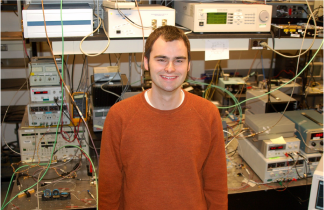Kieu and his collaborators at Arizona have been doing just that by developing SAs using carbon nanotubes. Though not the primary motivation, Amer Nevet, from Technion in Haifa, and his collaborators have also been developing effective SAs by showing the first example of two-photon gain in semiconductors, CKK1, "Direct Observation of Two-Photon Gain in Semiconductors."

From CLEO abstract CTuII2
Kieu's novel SA made from carbon nanotubes, packaged in a fused, fiber-coupler, has allowed him to make robust, few-cycle pulses in an all-fiber, ultra-compact footprint(see the Figure above from his Abstract). In fact, I have had some first-hand experience recently with building a similar oscillator. Using a fused carbon-nanotube SA from Kphotonics, a spin-off company started by Kieu, and approximately $500 of fiber components, it took only a couple hours of splicing for me to generate a self-starting 400 fs oscillator. It mode-locked the very first time I turned it on and requires no adjustment other turning up the pump power (truly turn-key). This is the easiest laser that I have ever built. Besides applications of this source for fiber-based frequency combs (CLEO talk CMX4) and super-continuum sources, Kieu is trying to market this laser for use in classroom demonstrations and teaching labs at the college level.

From CLEO abstract CTuKK1
The picture above shows the waveguide structure used by Amir Nevet and his collaborators to demonstrate two-photon gain. Two-photon gain is generated when a photon pair stimulates the emission of another identical photon pair in a second-order process (see schematic below). This means that gain is nonlinear, and now proportional to intensity. A pulse amplified in this way will experience larger gain at the peak and lower gain elsewhere. This has the same effect as a saturable absorber- even better, however, since the pulse experiences net gain rather than net loss. This technology holds great promise of changing typical means of pulse compression and mode-locking. The other great things about two-photon gain is it could be used for bi-stability and generating squeezed states of light.

Electron transition diagram of fully (doubly) stimulated two-photon emission

I would like to thank you for the efforts you have made in writing this article. I am hoping the same best work from you in the future as well.
ReplyDeleteMoisture Management